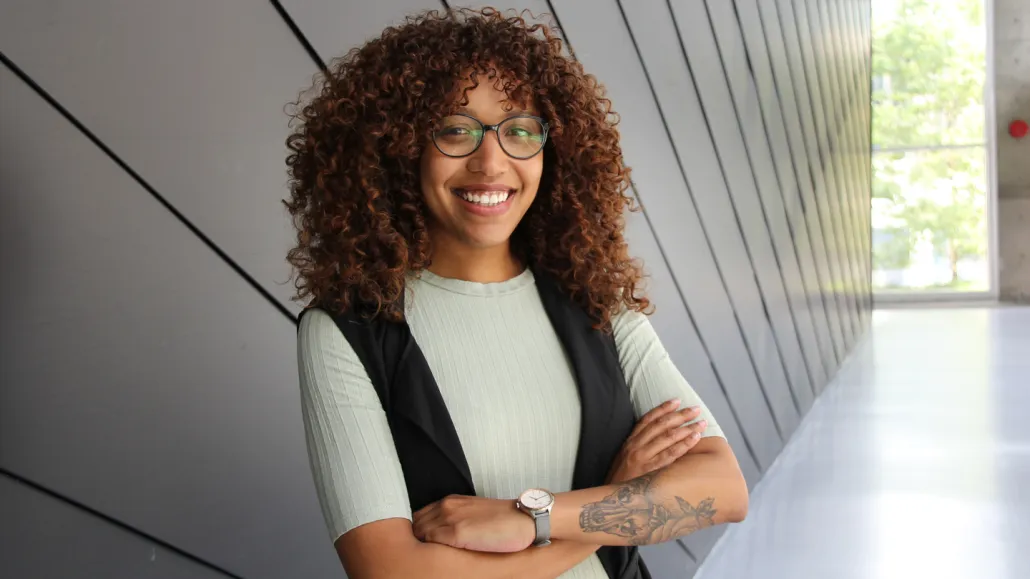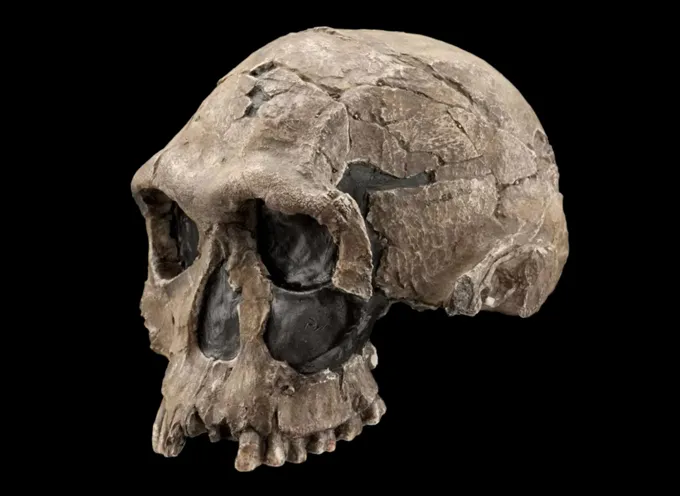
Lauren Schroeder studies the processes that have driven human evolution. She has a tattoo of her favorite fossil, a 2-million-year-old Homo habilis skull.
Blake Eligh/University of Toronto
Lauren Schroeder has loved dinosaurs since age 3 and bones since she was 10. In her second year of university, she started studying the early evolution of the Homo genus and it turned into her Ph.D. Many fossils have taken her breath away, she says, but a 2-million-year-old Homo habilis skull holds such a special place in her heart that it’s tattooed on her forearm.
“I think I can safely say that I’m doing what I wanted to do,” she says.

As a paleoanthropologist at the University of Toronto, Schroeder works to untangle the various processes by which humans have evolved. One such process, natural selection, is adaptive: Changes in an organism’s features make it more suited to its environment. But some changes are not selected for, or even totally random. Despite the existence of “nonadaptive” processes, paleoanthropology has often attributed evolutionary changes in hominids to adaptation alone.
While a Ph.D. student at the University of Cape Town in South Africa, Schroeder questioned the emphasis on natural selection to explain changes seen in the fossil record. “It was very clear that something was missing,” she says. Not much research had considered the role played by nonadaptive processes, such as genetic drift and gene flow. “That was really the big moment for me … these are important questions that haven’t really been asked. I should try to answer them.”
Since then, her research has suggested that nonadaptive processes play a much bigger role in evolution than previously realized.
“All aspects of Lauren’s research have been consequential for the discipline,” says Benjamin Auerbach, a biological anthropologist at the University of Tennessee, Knoxville. “We’re witnessing maybe a change in the way we talk about human evolution.”
The importance of chance
Schroeder’s research centers around questions of how and why body features in humans (or other animals) — called “morphology” — came to be.
They are hard questions to answer, in part because fossils often don’t contain usable DNA. Paleoanthropologists rely on patterns in the morphology, established theory and statistical analyses to try to understand the evolutionary processes at play. It’s math “all the way through,” Schroeder says — which is good, because she adores math.
Before the math, Schroeder measures the features of the fossils. During her Ph.D. research, she traveled across Africa to scan and analyze fossil Homo skulls dating from 2.8 million years ago until just tens of thousands of years ago. Some features of the skulls showed a strong adaptive signal, including the jaw; that means that early Homo jaw shape probably evolved via natural selection, driven by a changing diet.
But surprisingly, when Schroeder looked at the results for the shape of braincases across the Homo genus, genetic drift appeared to be at play, she reported in 2017 in the Journal of Human Evolution. A nonadaptive process, genetic drift is the loss of genetic variation in a population due to the chance disappearance of certain genes. In other words, the braincase shape evolved just because.

Schroeder also turns to today’s animals to better understand the evolution of our ancestors. Another nonadaptive process — gene flow — occurs when genes spread from one population to another through breeding, including when two species hybridize. Hybrids in the fossil record could thus offer clues to evolutionary processes. But there’s currently no good way to determine whether a fossil represents a hybrid.
Schroeder aims to change that by developing a framework based on morphological patterns in living hybrids. So far she’s focused on the skulls of coyote-wolf hybrids (chosen in part because Schroeder loves dogs), and she’s identified traits consistent with other hybrids, she and colleagues reported in 2021 in Journal of Morphology, including a higher incidence of dental and other anomalies.
Rewriting narratives
Schroeder, who grew up in South Africa, remembers noticing as early as her undergraduate years that most of the paleoanthropological research in her country was conducted by foreign researchers. In fact, less than 5 percent of papers published in the Journal of Human Evolution from 2016 to 2021 were authored by African researchers, Schroeder reported in the journal this past January.
Additionally, “even though most of it is based in Africa, paleoanthropology is so white,” she says. As a Black African woman, “it was such a lonely place, actually, for a long time.” Schroeder has struggled to publish papers, received sexist reviews on papers and experienced instances of blatant racism.
Some things have improved. At American Association of Biological Anthropologists conferences, she used to be able to count the number of Black people on two hands, she says. When she attended this past May, she was one of many. But there is still a long way to go. She credits her mentors for helping her get through the tough early years and the Black in BioAnth Collective for working to transform the field.
“It’s not an easy journey getting to where she is, but she’s there,” says Rebecca Ackermann, Schroeder’s Ph.D. adviser at the University of Cape Town. “And so now the world is her oyster.”
Schroeder recently secured tenure at the University of Toronto. As the first in her family to attend university, it means a lot to her and her parents. “They don’t necessarily get everything I do,” she laughs. But “we’re in disbelief that I’ve gotten here.”
Lauren Schroeder is one of this year’s SN 10: Scientists to Watch, our list of 10 early and mid-career scientists who are making extraordinary contributions to their field. We’ll be rolling out the full list throughout 2023.
Want to nominate someone for the SN 10? Send their name, affiliation and a few sentences about them and their work to sn10@sciencenews.org.







